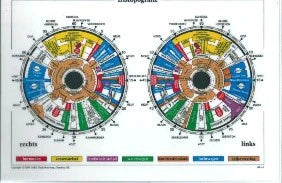
The mesmerising pigeon eye and "supercharged" vitamin D
Pathologists and radiologists dedicate years to acquiring and refining medical visual observation skills. They need this to view and interpret the images used to make a diagnosis.
Thus, it is crucial to understand how this works and which imaging features and characteristics are essential for accurate diagnostic performance by the physician.
Critical insights into human behavioural tasks can often be obtained using appropriate animal models. The pigeon (Columba Livia) - which shares many visual system properties with humans - may serve as a promising observer of medical images, an ability that has never before been documented.
They appear to be remarkably able to distinguish benign from malignant human breast tumours based on tissue images. They achieved this by training (providing them with specific food depending on whether they drew the right or wrong conclusions).
More significantly, the pigeon can generalise what it has learned when confronted with new image sets. Like humans, the pigeon's histological (concerning microscopic tissue sections) accuracy was moderately affected by the presence or absence of colour and the degree of image compression. Still, these effects could be improved with further training.

In radiology, the pigeon could detect cancer-relevant microcalcifications on mammogram images.

However, when given a different task (and also quite difficult for humans), namely classifying suspicious mammographic densities (masses), the pigeons only proved capable of memorising images.
The achievements and difficulties suggest that pigeons are well suited to help us better understand (human) medical image perception. They may also be helpful in performance evaluation and development of medical image equipment, image processing and image analysis tools.

Thus, when taking a pigeon into hand and judging it, fanciers also look very carefully at the fascinating pigeon's eye. Although this can be only healthy or sick, some fanciers occasionally look for unique qualities by interpreting patterns and colours of the eye. In my opinion, this is instead a superstition.
The eyes of pigeons have always intrigued us, and for a very long time, theories (iriscope) were developed to attribute specific flight performance to a pigeon's eye.

This, according to most scientists, tends to lean towards quackery. The pigeon was originally a cave resident(see previous blogs).
In this protected environment, she and her community stayed together all day unless she had to get out to gather food. This lifestyle is no longer consistent with the current situation in the lofts. We are always advised to provide plenty of air and light.
Plenty of fresh air, yes, plenty of light, no, says my good friend Pol Huls, a wise fancier who, in his early years, spent days in libraries, searching and wrestling through all available literature to arrive at a total picture and complete understanding of the pigeon.
His impressive record proves that he has more than succeeded in this!
His pigeons sit in the twilight, so to speak, as their ancestors once did in the caves.
And what is the result?
No eye problems, either bacterial or viral. The eyes are perfectly healthy due to being at rest and unburdened. One might argue that daylight is necessary as it ensures vitamin D production.
Vitamin D is a factor in which the free-cave pigeon serves itself with the UV (daytime) light it needs. This contrasts with the partially captive racing pigeon, which may or may not be forcibly darkened.
Therefore, Vitamin D is not a vitamin but a hormone made in one part of the body to be used in another.
Vitamin D is barely present in cereals. Most of it is found in fish. Also, in eggs (that's why they are consumed immediately when broken so as not to lose anything). With forced darkening, there is not always a risk of deficiency for as long as they get sufficient (at least 20 min) outdoor light during the day...
Then there is the "Vitamin D connection" from Dr Campbell's book, who states in "the China study" on page 360 that vitamin D must first be converted to "supercharged vitamin D", the one that only takes care of its natural effect. Numerous serious diseases (cancer, cardiovascular disease, autoimmune diseases etc...) are attributed to a deficiency of this supercharged form of vitamin D.
Using the link below, I gladly share this precious book.
https://issuhub.com/view/index/4548?page=19
According to his insights, the conversion to this super active vitamin D is prevented in humans by animal nutrition. I have therefore become a strict vegan since 2011 after reading this work. My health has only improved since then.
Now that our earth is under tremendous pressure, it makes sense to take a look and go back to basics... As former troglodytes, perhaps we should finally wake up now that, for example, glaciers are melting much faster than predicted in Europe. It is not good because they form our tens of thousands of years-old fresh drinking water buffer that keeps our rivers flowing. Agriculture -on the fertile sludge carried away- has always been the foundation of our prosperity.
In a few decades, they will be gone, however much the Swiss try with the courage of despair to prevent it by putting white lines over them—a tragic scene. We are definitely up to no good. Shouldn't we unwind more locally near "our cave"? Flying thousands of kilometres to worship the sun is unsuitable for our climate, budget, skin (huge in massive malignant tumours), and eyes.
Let pigeons travel https://pubmed.ncbi.nlm.nih.gov/1731731/.
We also recommend adding Comin-Cholin B-Complex to the drinking water during this period. Comin-Cholin B-complex will help the pigeon at the end of the season to rebuild its strength against the start of the moulting season and help the young pigeons to cope well with the stress of transportation.



